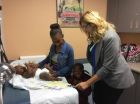(Press-News.org) Bottom Line: Very-low-birth-weight (VLBW) babies who undergo major surgery appear to have an increased risk of death or subsequent neurodevelopmental impairment (NDI).
Author: Frank H. Morriss, Jr., M.D., M.P.H., of the University of Iowa, Iowa City, and colleagues.
Background: Some animal studies suggest general anesthesia for surgery can increase the risk for neurocognitive or behavioral deficits. This has raised some concerns about exposing infants to general anesthesia for surgery.
How the Study Was Conducted: The authors examined the association between very-low-birth-weight infants who underwent surgery and the risk for death or NDI. Surgery was classified as major (the administration of general anesthesia) or minor (without general anesthesia). The study included patients enrolled in the National Institute of Child Health and Human Development Neonatal Research Network Generic Database from 1998 through 2009. A total of 12,111 infants were included in the analyses.
Results: A total of 2,186 infants underwent major surgery, 784 had minor surgery and 9,141 had no surgery. Most infants who underwent surgery did so once, but 1,080 had multiple procedures. Very-low-birth-weight infants who underwent major surgery appeared to have a more than 50 percent increased risk of death or NDI at 18 to 22 months of age. However, in the present analysis, the specific type of anesthesia used was not documented and data on dosing and other drugs administered were not available.
Discussion: "Exposure of VLBW infants to major surgery is associated with increased risk of death or NDI and of NDI among survivors, each by approximately 50%. The contribution of general anesthesia to this effect is suspected but not yet proven."
INFORMATION:
(JAMA Pediatr. Published online June 16, 2014. doi:10.1001/jamapediatrics.2014.307. Available pre-embargo to the media at http://media.jamanetwork.com.)
Editor's Note: Please see article for additional information, including support, other authors, author contributions and affiliations, etc.
Editorial: The Neonatologist's Role in Pediatric Anesthesia Neurotoxicity
In a related editorial, Robert Williams, M.D., of the University of Vermont, Burlington, and colleagues write: "In this context, we welcome the publication by Morriss et al in this issue of the journal. However, as is true with every human neurotoxicity study to date, their work raises as many questions as it answers."
"Consequently, without further specific information regarding the types of anesthesia administered, the conclusions of Morriss et al must remain speculative," the authors continue.
"While we wait for definitive information there is much we can do. At the present time, there is no definitive evidence that exposure to general anesthesia causes neurotoxicity and neither surgery nor anesthesia should be withheld from children if needed," they conclude.
(JAMA Pediatr. Published online June 16, 2014. doi:10.1001/jamapediatrics.2014.469. Available pre-embargo to the media at http://media.jamanetwork.com.)
Editor's Note: Please see article for additional information, including other authors, author contributions and affiliations, etc.
Media Advisory: To contact author Frank H. Morriss, Jr., M.D., M.P.H., call Jennifer Brown at 319-356-7124 or email jennifer-l-brown@uiowa.edu. To contact editorial author Robert Williams, M.D., call Jennifer Nachbur at 802-656-7875 or email jennifer.nachbur@uvm.edu.
Please visit the JAMA Pediatrics website (http://bit.ly/1adWrco) for an author audio interview after the embargo lifts.
Major surgery associated with increased risk of death or impairment in very-low-birth-weight infants
2014-06-16
ELSE PRESS RELEASES FROM THIS DATE:
Military personnel with concussive TBI caused by blast or nonblast event no difference in outcomes
2014-06-16
Bottom Line: Military personnel with concussive traumatic brain injury (TBI) caused by a blast or a nonblast-related event had similar outcomes, including headache severity and depression.
Author: Christine L. Mac Donald, Ph.D., of the Washington University School of Medicine, St. Louis, and colleagues.
Background: It has been estimated that in the U.S. military about 20 percent of the deployed force experienced a head injury in the wars in Iraq and Afghanistan. Of those injured, about 83 percent had a mild, uncomplicated TBI or concussion. Blast injuries were the ...
Outreach doubles colon cancer screening in low-income communities
2014-06-16
CHICAGO --- In low-income and minority communities where colonoscopies may be prohibitively expensive for many residents, less-invasive, more frequent testing combined with automated reminders, can yield dramatic improvements in colorectal cancer (CRC) screening rates, according to a new Northwestern Medicine® study.
The study found that community health center patients who received follow-up -– that is, outreach by mail, automated telephone and text messages, and calls by a health center staff member if no response was given in three months -- were more than twice as ...
Penn anesthesiologists identify top 5 practices that could be avoided
2014-06-16
(PHILADELPHIA) – A team of researchers led by Penn Medicine anesthesiologists have pinpointed the "top five" most common perioperative procedures that are supported by the least amount of clinical evidence, in an effort to direct providers to make more cost-effective treatment decisions. Their findings are published in the current issue of JAMA Internal Medicine.
The team surveyed anesthesiologists, many of them in academic practice, to identify the most common activities that should be questioned in the field, using practice parameters developed by the American Society ...
In military personnel, no difference between blast and nonblast-related concussions
2014-06-16
Explosions are the most common cause of traumatic brain injuries in veterans returning from Iraq and Afghanistan. A new study shows that military personnel with mild brain trauma related to such blasts had outcomes similar to those with mild brain injury from other causes, according to researchers at Washington University School of Medicine in St. Louis.
However, nearly 80 percent of patients in both categories of brain trauma suffered moderate to severe overall disability within a year after injury.
The analysis appears June 16 in JAMA Neurology.
"We are interested ...
How to prevent disparities in colon cancer screening
2014-06-16
SEATTLE—People living in poverty are less likely to be screened regularly for colorectal cancer—and more likely to develop the disease and die from it. How to end these disparities—and raise screening rates, lower disease rates, and prevent deaths? A promising way is to mail fecal immunochemical tests (a newer kind of stool test) to populations, Beverly B. Green, MD, MPH, and Gloria D. Coronado, PhD, wrote in the June 17 JAMA Internal Medicine.
Dr. Green is a Group Health physician and an associate investigator at Group Health Research Institute. Dr. Coronado is a senior ...
When patients wish for a miracle, tool helps medical staff say 'amen'
2014-06-16
Cancer clinicians and a chaplain at the Johns Hopkins Kimmel Cancer Center have developed a new tool to help doctors, nurses and other health care providers talk to dying patients and families who are, literally, praying for a miracle.
The AMEN (Affirm, Meet, Educate, No matter what) protocol, a script that can be used by medical staff, offers a way to negotiate these challenging conversations to affirm or acknowledge a patient's hope, share the patient's wish with others, continue to educate the patient and family about medical issues, and assure them that their health ...
Redesigning the well-child checkup
2014-06-16
Well-child visits are the foundation of pediatric primary care in the U.S. Accounting for more than one-third of all outpatient visits for infants and toddlers, the appointments are intended to give doctors the opportunity to identify health, social, developmental and behavioral issues that could have a long-term impact on children's lives.
However, several studies have shown that the current system of well-child care leaves room for improvement. One major concern is that well-child care guidelines issued by the American Academy of Pediatrics call for physicians to provide ...
Many bodies prompt stem cells to change
2014-06-16
HOUSTON – (June 16, 2014) – How does a stem cell decide what path to take? In a way, it's up to the wisdom of the crowd.
The DNA in a pluripotent stem cell is bombarded with waves of proteins whose ebb and flow nudge the cell toward becoming blood, bone, skin or organs. A new theory by scientists at Rice University shows the cell's journey is neither a simple step-by-step process nor all random.
Theoretical biologist Peter Wolynes and postdoctoral fellow Bin Zhang set out to create a mathematical tool to analyze large, realistic gene networks. As a bonus, their open-access ...
Researchers create better methods to detect E. coli
2014-06-16
MANHATTAN, KANSAS — Kansas State University diagnosticians are helping the cattle industry save millions of dollars each year by developing earlier and accurate detection of E. coli.
Lance Noll, master's student in veterinary biomedical science, Greensburg; T.G. Nagaraja, university distinguished professor of diagnostic medicine and pathobiology; and Jianfa Bai, assistant professor in the Kansas State Veterinary Diagnostic Laboratory, are leading a project to improve techniques for detecting pathogenic Shiga toxin-producing E. coli O157:H7. A U.S. Department of Agriculture ...
Getting rid of old mitochondria
2014-06-16
It's broadly assumed that cells degrade and recycle their own old or damaged organelles, but researchers at University of California, San Diego School of Medicine, The Johns Hopkins University School of Medicine and Kennedy Krieger Institute have discovered that some neurons transfer unwanted mitochondria – the tiny power plants inside cells – to supporting glial cells called astrocytes for disposal.
The findings, published in the June 17 online Early Edition of PNAS, suggest some basic biology may need revising, but they also have potential implications for improving ...





